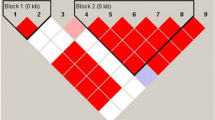Abstract
Systemic lupus erythematosus (SLE) is the prototype autoimmune rheumatic disease. The etiology of this disease is incompletely understood; however, environmental factors and genetic predisposition are involved. Cytokine-mediated immunity plays a crucial role in the pathogenesis of SLE. We investigate the association of interleukin-10 (IL-10) promoter polymorphisms and their haplotypes in SLE patients from the western Mexico. One hundred and twenty-five SLE patients fulfilling the 1997 ACR criteria and 260 unrelated healthy subjects (HS), both Mexican mestizos, were genotyped for IL-10 −1082A>G, −819C>T, and −592C>A polymorphisms. Haplotypes were inferred using the expectation–maximization algorithm, then allele and haplotype distributions were compared between patients and HS, as well as patients with different clinical variables. We identified at −1082, −819, and −592 four predominant haplotypes ACC (43.70 % in patients vs 46.55 % in HS), ATA (21.45 vs 22.97 %), GCC (16.28 vs 14.21 %), and GTA (14.12 vs 14.12 %). The ATC haplotype was more frequent in SLE respect to HS, suggesting a risk effect (3.23 vs 1.05 %; OR 3.55, CI 1.14–11.11; p = 0.0293). SLE patient carriers of −592 CC genotype as well as the dominant model of inheritance showed higher sIL-10 respect to AA genotype, suggesting that −592 C allele is associated with increased production of the cytokine (p < 0.05). The ACC haplotype had higher IL-10 serum levels and higher values of Mexican version of the Systemic Lupus Erythematosus Disease Activity Index compared with the other haplotype carriers; however, no association was found regarding autoantibodies. Our data suggest that the IL-10 promoter haplotypes play an important role in the risk of developing SLE and influence the production of IL-10 in Mexican population. Nevertheless, further studies are required to analyze the expression of mRNA as well as to investigate the interacting epigenetic factors that could help to define the true contribution of this marker in SLE pathogenesis.

Similar content being viewed by others
References
Kyttaris VC, Juang Y-T, Tsokos GC. Immune cells and cytokines in systemic lupus erythematosus: an update. Curr Opin Rheumatol. 2005;17:518–22.
Su D-L, Lu Z-M, Shen M-N, et al. Roles of pro- and anti-inflammatory cytokines in the pathogenesis of SLE. J Biomed Biotechnol. 2012;2012:1–15.
Llorente L, Zou W, Levy Y, et al. Role of interleukin 10 in the B lymphocyte hyperactivity and autoantibody production of human systemic lupus erythematosus. J Exp Med. 1995;181:839–44.
Llorente L, Richaud-Patin Y, Couderc J, et al. Dysregulation of interleukin-10 production in relatives of patients with systemic lupus erythematosus. Arthritis Rheum. 1997;40:1429–35.
Gröndal G, Kristjansdottir H, Gunnlaugsdottir B, et al. Increased number of interleukin-10-producing cells in systemic lupus erythematosus patients and their first-degree relatives and spouses in Icelandic multicase families. Arthritis Rheum. 1999;42:1649–54.
Gröndal G, Gunnarsson I, Rönnelid J, et al. Cytokine production, serum levels and disease activity in systemic lupus erythematosus. Clin Exp Rheumatol. 2000;18:565–70.
Houssiau FA, Lefebvre C, Vanden Berghe M, et al. Serum interleukin 10 titers in systemic lupus erythematosus reflect disease activity. Lupus. 1995;4:393–5.
Iyer SS, Cheng G. Role of interleukin 10 transcriptional regulation in inflammation and autoimmune disease. Crit Rev Immunol. 2012;32:23–63.
Suárez A, López P, Mozo L, et al. Differential effect of IL10 and TNF{alpha} genotypes on determining susceptibility to discoid and systemic lupus erythematosus. Ann Rheum Dis. 2005;64:1605–10.
Chong WP, Ip WK, Wong WH-S, et al. Association of interleukin-10 promoter polymorphisms with systemic lupus erythematosus. Genes Immun. 2004;5:484–92.
Mok CC, Lanchbury JS, Chan DW, et al. Interleukin-10 promoter polymorphisms in Southern Chinese patients with systemic lupus erythematosus. Arthritis Rheum. 1998;41:1090–5.
Lazarus M, Hajeer AH, Turner D, et al. Genetic variation in the interleukin 10 gene promoter and systemic lupus erythematosus. J Rheumatol. 1997;24:2314–7.
Eskdale J, Wordsworth P, Bowman S, et al. Association between polymorphisms at the human IL-10 locus and systemic lupus erythematosus. Tissue Antigens. 1997;49:635–9.
Zhou M, Ding L, Peng H, et al. Association of the interleukin-10 gene polymorphism (−1082A/G) with systemic lupus erythematosus: a meta-analysis. Lupus. 2013;22:128–35.
Wang B, Zhu J-M, Fan Y-G, et al. Association of the −1082G/A polymorphism in the interleukin-10 gene with systemic lupus erythematosus: a meta-analysis. Gene. 2013;519:209–16.
Song GG, Choi SJ, Ji JD, et al. Associations between interleukin-10 polymorphisms and susceptibility to systemic lupus erythematosus: a meta-analysis. Hum Immunol. 2013;74:364–70.
Hochberg MC. Updating the American College of Rheumatology revised criteria for the classification of systemic lupus erythematosus. Arthritis Rheum. 1997;40:1725.
Guzmán J, Cardiel MH, Arce-Salinas A, et al. Measurement of disease activity in systemic lupus erythematosus. Prospective validation of 3 clinical indices. J Rheumatol. 1992;19:1551–8.
Gladman DD, Urowitz MB, Goldsmith CH, et al. The reliability of the Systemic Lupus International Collaborating Clinics/American College of Rheumatology Damage Index in patients with systemic lupus erythematosus. Arthritis Rheum. 1997;40:809–13.
Gorodezky C, Alaez C, Vázquez-García MN, et al. The genetic structure of Mexican Mestizos of different locations: tracking back their origins through MHC genes, blood group systems, and microsatellites. Hum Immunol. 2001;62:979–91.
Miller SA, Dykes DD, Polesky HF. A simple salting out procedure for extracting DNA from human nucleated cells. Nucleic Acids Res. 1988;16:1215.
Boiardi L, Casali B, Farnetti E, et al. Interleukin-10 promoter polymorphisms in giant cell arteritis. Arthritis Rheum. 2006;54:4011–7.
Santos AR, Suffys PN, Vanderborght PR, et al. Role of tumor necrosis factor-alpha and interleukin-10 promoter gene polymorphisms in leprosy. J Infect Dis. 2002;186:1687–91.
Excoffier L, Slatkin M. Maximum-likelihood estimation of molecular haplotype frequencies in a diploid population. Mol Biol Evol. 1995;12:921–7.
Lewontin RC. The interaction of selection and linkage. I. General considerations; heterotic models. Genetics. 1964;49:49–67.
Gavrilets S. Population genetics: multilocus. In: Encyclopedia of life sciences, 1st ed. Wiley; 2001.
Lander E, Kruglyak L. Genetic dissection of complex traits: guidelines for interpreting and reporting linkage results. Nat Genet. 1995;11:241–7.
Turner DM, Williams DM, Sankaran D, et al. An investigation of polymorphism in the interleukin-10 gene promoter. Eur J Immunogenet Off J Br Soc Histocompat Immunogenet. 1997;24:1–8.
Edwards-Smith CJ, Jonsson JR, Purdie DM, et al. Interleukin-10 promoter polymorphism predicts initial response of chronic hepatitis C to interferon alfa. Hepatology. 1999;30:526–30.
Alarcón-Riquelme ME, Lindqvist AK, Jonasson I, et al. Genetic analysis of the contribution of IL10 to systemic lupus erythematosus. J Rheumatol. 1999;26:2148–52.
Vargas-Alarcon G, Ramírez-Bello J, Juárez-Cedillo T, et al. Distribution of the IL-1RN, IL-6, IL-10, INF-γ, and TNF-α gene polymorphisms in the Mexican population. Genet Test Mol Biomarkers. 2012;16:1246–53.
Font J, García-Carrasco M, Ramos-Casals M, et al. The role of interleukin-10 promoter polymorphisms in the clinical expression of primary Sjögren’s syndrome. Rheumatology. 2002;41:1025–30.
Rangel-Villalobos H, Muñoz-Valle JF, González-Martín A, et al. Genetic admixture, relatedness, and structure patterns among Mexican populations revealed by the Y-chromosome. Am J Phys Anthropol. 2008;135:448–61.
Zhu LJ, Liu ZH, Zeng CH, et al. Association of interleukin-10 gene −592 A/C polymorphism with the clinical and pathological diversity of lupus nephritis. Clin Exp Rheumatol. 2005;23:854–60.
Yu S-L, Kuan W-P, Wong C-K, et al. Immunopathological roles of cytokines, chemokines, signaling molecules, and pattern-recognition receptors in systemic lupus erythematosus. Clin Dev Immunol. 2012;2012:715190.
Doreau A, Belot A, Bastid J, et al. Interleukin 17 acts in synergy with B cell-activating factor to influence B cell biology and the pathophysiology of systemic lupus erythematosus. Nat Immunol. 2009;10:778–85.
Palafox Sánchez CA, Satoh M, Chan EK, et al. Reduced IgG anti-small nuclear ribonucleoprotein autoantibody production in systemic lupus erythematosus patients with positive IgM anti-cytomegalovirus antibodies. Arthritis Res Ther. 2009;11:1–12.
Filaci G, Bacilieri S, Fravega M, et al. Impairment of CD8+ T suppressor cell function in patients with active systemic lupus erythematosus. J Immunol. 2001;166:6452–7.
Konya C, Paz Z, Tsokos GC. The role of T cells in systemic lupus erythematosus: an update. Curr Opin Rheumatol. 2014;26:493–501.
Filaci G, Fravega M, Negrini S, et al. Nonantigen specific CD8+ T suppressor lymphocytes originate from CD8+CD28− T cells and inhibit both T-Cell proliferation and CTL function. Hum Immunol. 2004;65:142–56.
Grammatikos AP, Kyttaris VC, Kis-Toth K, et al. A T cell gene expression panel for the diagnosis and monitoring of disease activity in patients with systemic lupus erythematosus. Clin Immunol. 2014;150:192–200.
Csiszar A, Nagy GY, Gergely P, et al. Increased interferon-gamma (IFN-γ), IL-10 and decreased IL-4 mRNA expression in peripheral blood mononuclear cells (PBMC) from patients with systemic lupus erythematosus (SLE). Clin Exp Immunol. 2000;122:464–70.
Acknowledgments
This work was supported by Grant No. 115567 to CAPS of the National Council of Science and Technology (CONACyT, México-Universidad de Guadalajara).
Conflict of interest
The authors declare no conflict of interest.
Author information
Authors and Affiliations
Corresponding author
Rights and permissions
About this article
Cite this article
Palafox-Sánchez, C.A., Oregon-Romero, E., Salazar-Camarena, D.C. et al. Association of interleukin-10 promoter haplotypes with disease susceptibility and IL-10 levels in Mexican patients with systemic lupus erythematosus. Clin Exp Med 15, 439–446 (2015). https://doi.org/10.1007/s10238-014-0315-4
Received:
Accepted:
Published:
Issue Date:
DOI: https://doi.org/10.1007/s10238-014-0315-4




